 |
 |
|
|
|
  |
| > Nishi Ward Toppage > Attractions / The land mark and
a historic spot, a historical walk way |
Landmarks and Historic Locations
The Origin of the Osaka City Railway
2-1, Chiyozaki, Nishi-ku, Osaka
|
The Osaka City Railway was first opened on the 12th of September 1903. It started at the eastern edge of the Hanazono Bridge on Kuji-shinmichi(currently the Kuji-shinmichi bus stop) and ran approximately 5km to Chikko Harbour. The railway consisted of a single track and in the beginning two-storey carriages were cool in the summer and packed with fishermen in the winter. Although this was the first civic run railway in Osaka, Kyoto led the way in 1895 with it's own railway while a line between Tokyo and Yokohama was opened up in 1903, the same year as Osaka. The Mayor at the time, Mr. Tsuruhara, commented, "if this is to become the legs of our city, it should be a public endeavour and not one that is out to chase up a profit". Although this railway had such a long tradition, it had totally disappeared by the beginning of World Expo held in Osaka in 1969.
|
 |
The Ruins of Eitai Bay
(In Kusunaga Shinto Shrine) 2-1, Utsubohommachi, Nishi-ku, Osaka
|
At the present day site of Utsubohonmachi there once was man-made canal called Umibe Horikawa. This canal was built in 1624 by dried fish merchants to carry their wares into the city. It began at Awa Horikawa canal, ran north through Umibe city and turned 90 degrees west into Miyako-machi Horikawa. The 724 metre stretch between Awa Horikawa canal and the 90 degree turning point was known as Eitai canal and the turning point itself was called Eitai Bay.
Eitai Bay was the landing spot for all of Utsubo's
seafood and dried fish products, including shaved benito.
In fact, the most famous of goods were dried sardines
and the market specializing in this was even listed
in "The Great Book of Setsu's Famous Spots". A memorial
monument inscribed with "Utsubo, Tsujinoyoshinotsuke
Yamanakanomasashichi" was set in June 1953. Nearby,
there is Kusunaga Shrine which includes the ruins of
Goryougu and The Kusunaga Omikami monument. There were
six bridges (Monpi bridge, Eitai bridge, Kamino bridge,
Nakano bridge, Kaibu bridge, Shimono bridge) spanning
the Kaibu Horikawa canal, but they and the canal were
totally buried over in 1951.
|
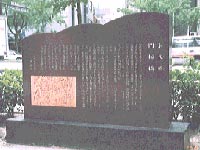 |
The Ruins of the Zakoba Fish Market
1-8, Enokojima, Nishi-ku, Osaka
|
The monument to the Zakoba Fish Market that stands near the road connecting Amagasaki and Sakai cities shows the area that included this market along with the Dojima Eastern Market and the Temma Produce Market. These three were the largest markets in Osaka during the Edo period. This area was once called Sagijima and was the place where fish mongers from Kamiuoya city (now Chuo Ward) set up branch stores between the years of 1615 and 1624. This place was used as the original markets were too far up river and in the summertime, there was always a good chance that the fish would go bad before reaching the customers. Many fish mongers gathered at this new spot, bringing with them various varieties of small fish (called zako in Japanese), therefore causing the name of Sagijima to become Zakoba (the place of small fish). In 1771, this market was officially recognized by the government and given the right to monopolize fish sales in Osaka. Then in November 1931, the market was amalgamated into the Osaka Central Markets and continues in this form to present day.
|
 |
The Ruins of the Osaka Prefecture Building
2-1, Enokojima, Nishi-ku, Osaka |
In July 1871, the central government ordered the abolition
of fiefdoms and the institution of prefectures. In November
of the same year, a major overhaul of the prefectural
system led to Osaka city to be made up of four wards (north,
south, east, west) and the remaining prefecture to be
made up of seven districts (Shimagami, Shimashimo,Toyoshima,
Nishinari, Higashinari, Sumiyoshi, Nose). At the time,
the Prefecture building was located at Higashiyokohori
but it was very cramped and was seen as unsuitable for
Prefecture government. So in 1872, the Osaka Prefecture
government in association with private construction companies,
began work on a new building at Enokojima. The reason
for this new building to be placed at Enokojima was that
it is located near the ocean and since it was believed
that Osaka would be the gateway to the rest of Western
Japan, all new Western culture and systems would have
to pass through here. This new Prefecture building was
completed in July 1874 and for six days in August was
open to the public. The main gate has four large pylons
lined up and the central dome displayed a huge clock.
This Western style of building became very popular and
was affectionately called the Enokojima government. It
was designed by the English architect Walters and is considered
(along with Sempukan) to be one of the great cultural
heritage spots in Osaka. In November 1926, the Prefecture
building moved to it's current postion in Chuo Ward but
for half a century Osaka was governed and progessed from
this building. At present, the Osaka Prefectural Industrial
Sciences Research Laboratories are built on this site,
but in the front garden there is a small stone monument
that shows that this was the old Prefecture building.
|
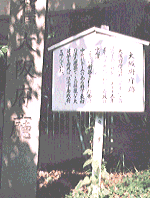 |
Kujo Island and The Korean Correspondents
(In Matsushima Park) 1-1, Chiyozaki, Nishi-ku, Osaka |
The area of Kujo was called Minamiura and consisted of
a sandbar that caused high and violent waves. During the
Kanei years of the Edo period (1624-1644), Sekiun Kouzai,
an important member of the Shogunate who had good knowledge
of the sea routes, worked together with the ruler of this
land, Jinbei Ikeyama, to develop the area. During the
Edo Period the Korean Correspondents visited Japan twelve
times, further deepening the bond between the two countries.
The correspondents would meet with prominent Osaka literary
figures and scholars on their way to and from Edo (present
day Tokyo). Nearby at Takebayashi Temple (Honda 1 Chome),
there is a monument honouring Kim Hanjung, a correspondent
that passed away while visiting Japan in 1764. Another
monument in Matsushima Park is entitled "Kujo Island and
The Korean Correspondents" and has the dying words of
Kim Hanjung and a song written by the head priest at the
time of Takebayashi Temple carved into it.
|
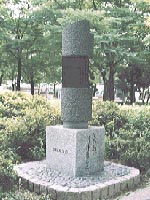 |
Aji River Tunnel
2-1, Ajigawa, Nishi-ku, Osaka |
The Aji and Kizu Rivers were seen to be difficult rivers over which to build bridges because the two rivers were used extensively for transportation. However, in 1873 an iron bridge was built as part of a plan to improve the transportation route to the foreign district of Osaka. In order for ships with tall masts to pass by, the bridge was built with the ability to turn, allowing them to pass. It was also known as the "Magnet" bridge and became a popular Osaka attraction. Over the Kizu River, a bridge with a raise able bottom was built to accommodate the ships, but both bridges were washed away in the great flood of 1885.
In 1897, a man by the name of Genpei extended his ferry business to include a landing at Kujyo-shinmichi. This ferry point was known as "Genpei's Aji River Landing" and was received by the merchants on either side of the river with great joy. Around this time, there were seven ferry landings in what is now known as Nishi Ward, but Genpei'Landing was the most widely used and because people from Nishi-Kujyo could easily travel across to Kujyo, this ferry can be said to have been an important factor in the development of the Kujyo area.
After entering the Showa Period (beginning in 1926), the increasing amount of traffic in Osaka led to the planning of an underground road here in 1935, and on the 15th of September 1944, what is generally known as the Aji River tunnel was opened. At the Nishi Ward and Konohana Ward ends, an elevator took the traffic down some 17 metres to the river's floor and then allowed them to travel through to the other side. At the time of opening, two tunnels (one for vehicles and the other for pedestrians) were put into use but in 1977 the tunnel for vehicles was permanently closed.
However, the pedestrian tunnel was (and still is) widely used, making it a famous spot in Western Osaka.
|
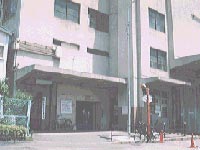 |
Wako Temple
3-7, Kitahorie, Nishi-ku, Osaka |
.In 1698, under orders from the Shogun ate, 1800 tsubo
(roughly 5951u) were taken from Eidai Temple and allocated
to Chizenshonin to build a temple to honour the holy site
as proclaimed by Zenkou Temple in Nagano Prefecture. This
temple was officially named Renchizanchizenin-wakoji
. According to "The Great Book of Famous Setsu Spots",
in the Edo Period this was a huge temple that consisted
of Kannon Hall/Fumon Hall/Aizen Hall/Yakushi Hall/Ma-ko
Jizo/Emma Hall/Jizo Hall/Konpiragongen/Kondo Jizo/Shou
Hall, while in and around the courtyard there is seating
available for lectures and ballad drama performances,
areas to view archery, puppetry theater, and demonstrations
of acrobatics, and other shops all lined up. Every year
in February there is the Nehan-e and in April there is
the Kanbutsue, making these times very lively. Other events
include Tomikuji (a type of lottery) and a tree market
but as is written in "The Great Book of Famous Setsu Spots",
the Amida Pond is the most famous and has been the inspiration
for many stories, rakugo (comedic storytelling) and plays.
At the edge of the pond there is a monument inscribed
with the poem roughly translated as [Although I want to
break off a cherry blossom branch to make it mine, I have
resigned for the flowers are meant to be admired while
alive]. Around the grounds
there are monuments detailing the history of Zenkou Temple,
various poems and songs, the passing of souls and their
achievements.
|
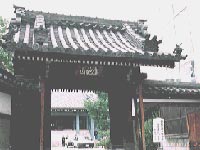 |
Tosainari Shinto Shrine
4-9, Kitahorie, Nishi-ku, Osaka
|
The Toasainari Shrine was the village shrine for Tosa Kouchi Hangura, and is said to have taken on the overflow of parishioners from the Yamashiro Fushimi Inari Shinto in 1770, and is an ancient building dating back to the Tensho era (1573-1592) and was said to have been opened to the general public by Yutaka Yamauchi in 1717.
During the Sakai Incident of 1868, Rainokichi Minou who stabbed a French soldier, was ordered to commit seppuku by the Meiji government who had acceded to the demands of French diplomat Roche, and the 20 to be sacrificed were chosen by lottery at the Inari Shrine and taken to Myoukoku Temple in Sakai. The grounds have been known for its cherry blossoms since the Edo period , and a monument erected in 1851 still stands. The temple and older cherry trees were destroyed in the air raids during the Pacific War but the temple was rebuilt, saplings were planted and the area once again presents beautiful cherry blossoms.
|
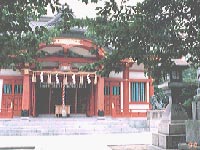 |
Osaka City Hall Enokojima Government Building Remains
1-9, Enokojima, Nishi-ku, Osaka |
Osaka city came into existence in April 1890 with a municiplization
project but with the simultaneous advent of the municiplization
special order the position of mayor was combined with
the prefectural governor and city hall was placed within
the ward office. With the abolition of the municiplization
special order in September, 1909 Osaka city was pressed
with its requirement for an independent government building
and in December of the following year city hall was relocated
to the north of the ward office on theKizugawa Higashizume
where it remained until May 1913 when it was relocated
to the Dojima government building.
|
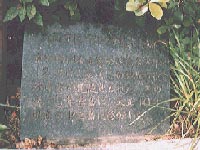 |
Kawaguchi Foreign Settlement Remains
(North West Corner of Honda Elementary Sshool) 1-5, Kawaguchi, Nishi-ku, Osaka |
With the opening of Osaka port, a foreign settlement was constructed in the town of Kawaguchi and in July 29, 1868 the Kawaguchi operations department began selling offleases in perpetuity for the 26 foreign settlement wards. As a result Great Britain (13 wards), France (2 wards), Germany (4 wards), the Netherlands (2 wards), the United States (4 wards), and Belgium (1 ward) made successful bids and a great deal of funds were collected. Thereafter, sewage systems were put in place, footpaths and roads were separated, gas lights illuminated the streets, and western buildings began to be constructed. Many of the first tenants were merchants with such products as beef, milk, bread, shoes, hats, and clothing, rare items to the Japanese people of the time which surprised the people. However, Osaka merchants were conservative towards these new products and furthermore as the area was inconvenient for the passage of large ships and the freedom of foreign merchants was not permitted the merchants eventually relocated to the Kobe foreign settlements. The tenants who came in afterwards were the Catholic Church and the schools and hospitals affiliated with them.
The Kawaguchi foreign settlement was, for the people of the time, representative of "The Progress of Civilization" but in 1910 it was cancelled and all leases that foreigners held were cancelled in March of 1943. Not a single building from the foreign settlement era has survived but the Kawaguchi Catholic church, originally built in 1874 and rebuilt in 1916 is a subtle reminder of the bygone era. In the northwestern corner of Honda Elementary School can be found the monument to the Kawaguchi Foreign Settlement erected by the city of Osaka on March, 1962.
|
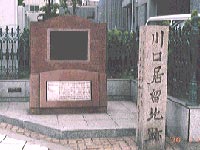 |
|
 |
|
 |
|
 |
